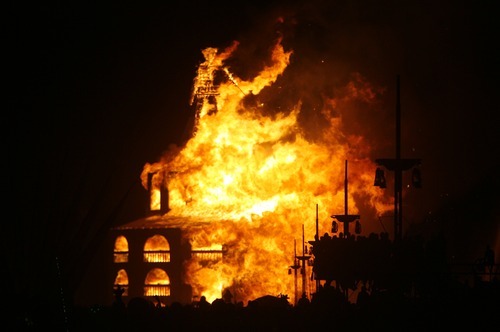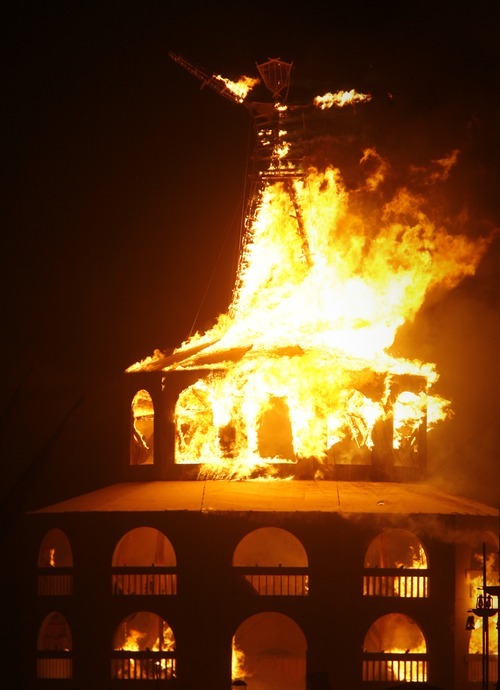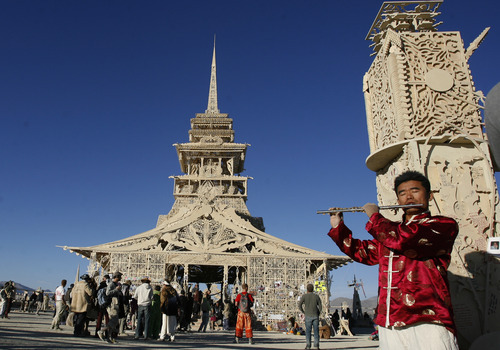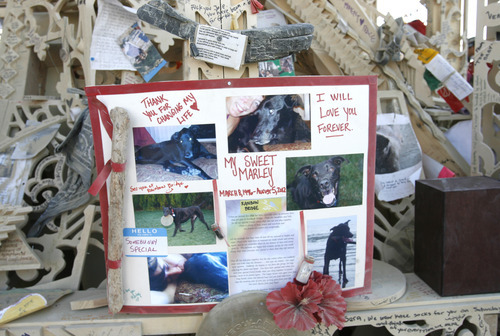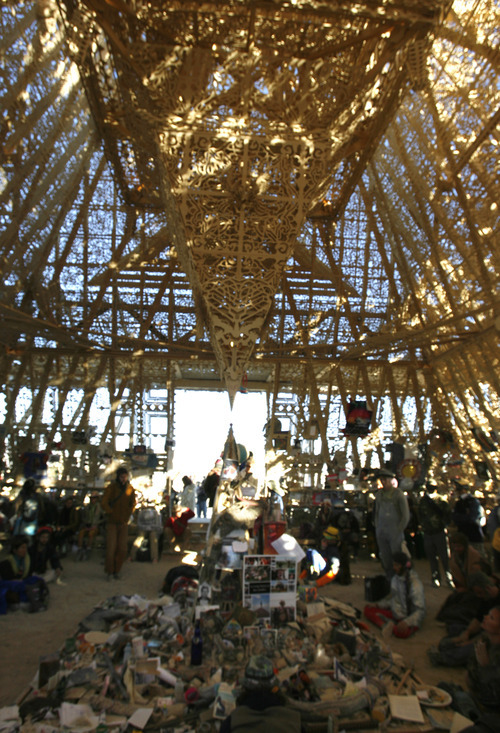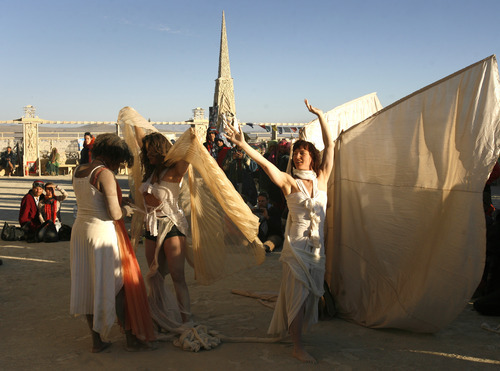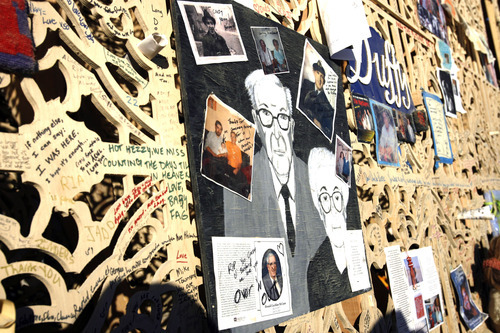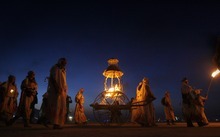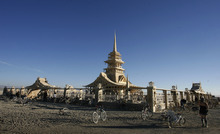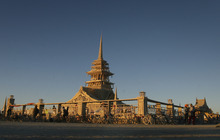This is an archived article that was published on sltrib.com in 2012, and information in the article may be outdated. It is provided only for personal research purposes and may not be reprinted.
Thousands gathered on a northern Nevada plain last week to watch and cheer as a 70-foot-tall white neon man was burned into extinction, amid raucous music, dancing and fireworks.
The annual Burning Man festival ended the next day with another ritual blaze: the destruction of a temporary temple, filled with photos and written memories of loved ones, pets, failed relationships, troubled pasts, old ideas and profound emotions hastily scrawled on pieces of paper, wood, cloth and cardboard. Some expressed anguish with words like "my life sucks." A woman hung up her wedding dress.
Unlike the previous night, the Sunday temple fire was quiet and reverential for the more than 60,000 seated on the ground.
It wasn't just about letting go of cherished family and friends, says Kent Frogley, a Salt Lake City marketing consultant who calls himself an "emeritus Mormon," but about how death transforms relationships.
Why build something so beautiful each year and then torch it?
"It's a deliberate statement about life's transitory nature," explains Frogley, who posted his mother's name and 1996 death date in last year's temple, "and the human proclivity to hang onto things."
For him and many others, Burning Man is a spiritual experience unlike any in traditional churches. It fills a hunger for unconventional spirituality and rituals, freed from churchy institutions and limits.
That is not how most outsiders view the weeklong confab.
Many see Burning Man as a drug-filled haze of hedonism — long on self-expression and exhibitionism, short on morals and restraint. Some Christian pastors have condemned it as a "tool of Satan."
Indeed, satanic revelry may be the appeal for some devotees, but others go there looking for their better natures. Either way, the gathering has tapped into a need and continues to swell.
—
Birth of a movement • In 1986, Larry Harvey and Jerry James burned an 8-foot wooden man on Baker Beach in San Francisco as a celebration of the summer solstice.
A couple of dozen onlookers seemed to relish the moment and urged the duo to make it an annual event, writes John Morehead, director of Utah's Western Institute for Intercultural Studies, who wrote a master's thesis on Burning Man for the now-defunct Salt Lake Theological Seminary.
The size of the man began to grow along with the number of followers.
Two years later, the experience became known as Burning Man and began to lure self-described free spirits from all over the Bay Area. Soon, it attracted about 800 participants.
In 1993, it took place during Labor Day week, moved to Nevada's Black Rock Desert 120 miles north of Reno and, Morehead writes, "become an experiment in intentional community."
This "Black Rock City" is based on 10 principles: "radical inclusion, gifting, decommodification, radical self-reliance, radical self-expression, communal effort, civic responsibility, leaving no trace, participation and immediacy."
Participants provide all their own needs, including food, bedding, tents, first aid and anything required for art installations. No money is exchanged and nothing is for sale, other than coffee and ice, so participants have developed a "gifting economy" in which people give one another objects or services that they need, with no expectation of payment or exchange.
Since attendance has mushroomed to tens of thousands, organizers say they have to charge a hefty fee — $250 to $400 apiece to pay for Porta-Potties, land-use fees and website maintenance, among other costs.
They also established a theme for each gathering, including Time, Hell, Outer Space, the Body, The Floating World, Beyond Belief, Vault of Heaven, Psyche, Hope and Fear, the Green Man, the American Dream, Evolution and Metropolis.
This year's theme was Fertility 2.0, the website says, and the temple was named for Juno, the Roman goddess "who was a fertility deity and overseer of childbirth, a protectress of women and the community, and a preserver of marriages."
Sounds not so different from how Christianity sees some of its mission, but taking an altogether different tack.
—
Message to the church • Christianity was once at the center of American culture, says Morehead, but no more.
"Along the way to the 21st century, the church has lost touch with its counterculture roots," he says in an interview. "If the church were in touch with the changing needs of the people, alternative spiritualities or places that incorporate all spiritualities like Burning Man would not be such a draw."
The modern church seems to have forgotten that early Christianity was once considered "countercultural" by the prevailing Roman and Jewish establishment, he writes in a recent online essay for Religion Dispatches. It was regarded "as deviant, and engaged in a variety of bizarre beliefs and rituals."
Contemporary Christianity has also neglected, he writes, "the significance of play as a possible 'signal of transcendence,' the importance of festivals with their rituals of inversion and the critique of society, and utopian considerations."
Morehead sees Burning Man as a kind of do-it-yourself spirituality that draws on various traditions and rituals, not simply as a pagan or New Age event.
"You'll find diverse spiritual expressions, including those two," he says, "but it refuses to be tied down to a particular meaning."
As part of his research, Morehead participated in the 2006 gathering — and he was surprised by what he saw.
"I met doctors, lawyers and business people, an amazingly diverse group, " he says. "It was a fascinating coalescing of people across the spectrum, all looking for different things and forming a community from scratch."
That's another aspect that the church could emulate, he says. "Instead of looking at elements we disagree with, we should engage in self-critique and learn from its good points."
Amber Barger, a self-described Christian from Sacramento, Calif., has attended Burning Man with her husband for eight years.
Barger, a photographer who owns a construction company with her husband, has not been bothered by the nudity or drugs, aspects that she says are no more prevalent than in, say, Los Angeles.
"It's the same as any other society," Barger says, "just condensed into a week."
She, like Morehead, finds much in the experience that could be replicated by the contemporary Christian church.
"I see churches moving more toward this," she says, "going into the community to spread love instead of expecting people to come to church to find God."
Barger then adds: "I think my pastor would love it there. He'd have a blast."
Pagan Pride Day
Salt Lake Pagan Pride will hold its annual Pagan Pride Day at Murray Park Pavilions 1, 2 and 3 on Sunday from 10 a.m. to 6 p.m. There will be music and booths. For admission, bring a nonperishable food item to donate for The Road Home. Visit http://www.saltlakeppd.org for information.


